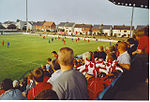St Cyrus National Nature Reserve

St Cyrus National Nature Reserve (NNR) is situated between the village of St Cyrus and the North Sea in the far south of the council area of Aberdeenshire in Scotland. The reserve comprises a narrow strip of land that is 3.5 km long and less than 500 m across at its widest point: the total area is 92 hectares (230 acres), most of which is only a few metres above sea level and bounded by cliffs to the west. It forms the northern third of Montrose Bay, with the River North Esk marking its southern boundary. The reserve was declared in 1962, and is managed by NatureScot. The cliffs and dunes provide a nationally important habitat for flowering plants and insects, many of which are at their northern limit in Britain. The reserve is one of the most important botanical sites on the north-east coast of Scotland, supporting over 300 plant species.A visitor centre run by NatureScot is located within an old lifeboat station, which also provides educational facilities for groups of school children, bird watchers and botanists. The centre opened in 1989 and underwent a major upgrade in 2004. As of 2008 around over 15,000 people visited the centre annually. NatureScot has waymarked a 1.5 km path known as the Tyrie Trail, and there several other paths across the reserve.
Excerpt from the Wikipedia article St Cyrus National Nature Reserve (License: CC BY-SA 3.0, Authors, Images).St Cyrus National Nature Reserve
A92,
Geographical coordinates (GPS) Address Website Nearby Places Show on map
Geographical coordinates (GPS)
| Latitude | Longitude |
|---|---|
| N 56.763801 ° | E -2.4183 ° |
Address
St Cyrus National Nature Reserve (St Cyrus NNR)
A92
DD10 0AN
Scotland, United Kingdom
Open on Google Maps







